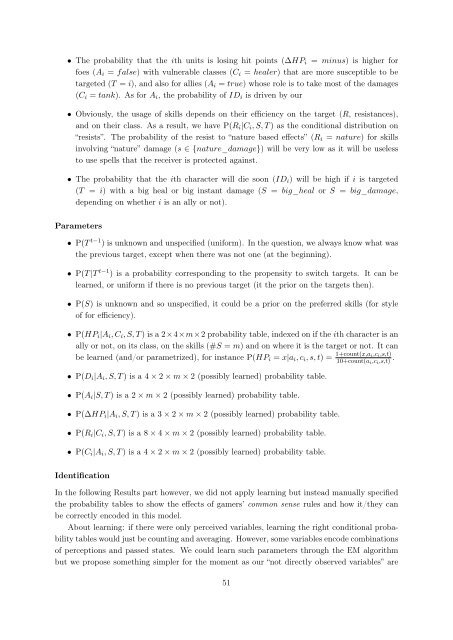Bayesian Programming and Learning for Multi-Player Video Games ...
Bayesian Programming and Learning for Multi-Player Video Games ...
Bayesian Programming and Learning for Multi-Player Video Games ...
You also want an ePaper? Increase the reach of your titles
YUMPU automatically turns print PDFs into web optimized ePapers that Google loves.
• The probability that the ith units is losing hit points (∆HPi = minus) is higher <strong>for</strong><br />
foes (Ai = false) with vulnerable classes (Ci = healer) that are more susceptible to be<br />
targeted (T = i), <strong>and</strong> also <strong>for</strong> allies (Ai = true) whose role is to take most of the damages<br />
(Ci = tank). As <strong>for</strong> Ai, the probability of IDi is driven by our<br />
• Obviously, the usage of skills depends on their efficiency on the target (R, resistances),<br />
<strong>and</strong> on their class. As a result, we have P(Ri|Ci, S, T ) as the conditional distribution on<br />
“resists”. The probability of the resist to “nature based effects” (Ri = nature) <strong>for</strong> skills<br />
involving “nature” damage (s ∈ {nature_damage}) will be very low as it will be useless<br />
to use spells that the receiver is protected against.<br />
• The probability that the ith character will die soon (IDi) will be high if i is targeted<br />
(T = i) with a big heal or big instant damage (S = big_heal or S = big_damage,<br />
depending on whether i is an ally or not).<br />
Parameters<br />
• P(T t−1 ) is unknown <strong>and</strong> unspecified (uni<strong>for</strong>m). In the question, we always know what was<br />
the previous target, except when there was not one (at the beginning).<br />
• P(T |T t−1 ) is a probability corresponding to the propensity to switch targets. It can be<br />
learned, or uni<strong>for</strong>m if there is no previous target (it the prior on the targets then).<br />
• P(S) is unknown <strong>and</strong> so unspecified, it could be a prior on the preferred skills (<strong>for</strong> style<br />
of <strong>for</strong> efficiency).<br />
• P(HPi|Ai, Ci, S, T ) is a 2×4×m×2 probability table, indexed on if the ith character is an<br />
ally or not, on its class, on the skills (#S = m) <strong>and</strong> on where it is the target or not. It can<br />
be learned (<strong>and</strong>/or parametrized), <strong>for</strong> instance P(HPi = x|ai, ci, s, t) = 1+count(x,ai,ci,s,t)<br />
10+count(ai,ci,s,t) .<br />
• P(Di|Ai, S, T ) is a 4 × 2 × m × 2 (possibly learned) probability table.<br />
• P(Ai|S, T ) is a 2 × m × 2 (possibly learned) probability table.<br />
• P(∆HPi|Ai, S, T ) is a 3 × 2 × m × 2 (possibly learned) probability table.<br />
• P(Ri|Ci, S, T ) is a 8 × 4 × m × 2 (possibly learned) probability table.<br />
• P(Ci|Ai, S, T ) is a 4 × 2 × m × 2 (possibly learned) probability table.<br />
Identification<br />
In the following Results part however, we did not apply learning but instead manually specified<br />
the probability tables to show the effects of gamers’ common sense rules <strong>and</strong> how it/they can<br />
be correctly encoded in this model.<br />
About learning: if there were only perceived variables, learning the right conditional probability<br />
tables would just be counting <strong>and</strong> averaging. However, some variables encode combinations<br />
of perceptions <strong>and</strong> passed states. We could learn such parameters through the EM algorithm<br />
but we propose something simpler <strong>for</strong> the moment as our “not directly observed variables” are<br />
51


